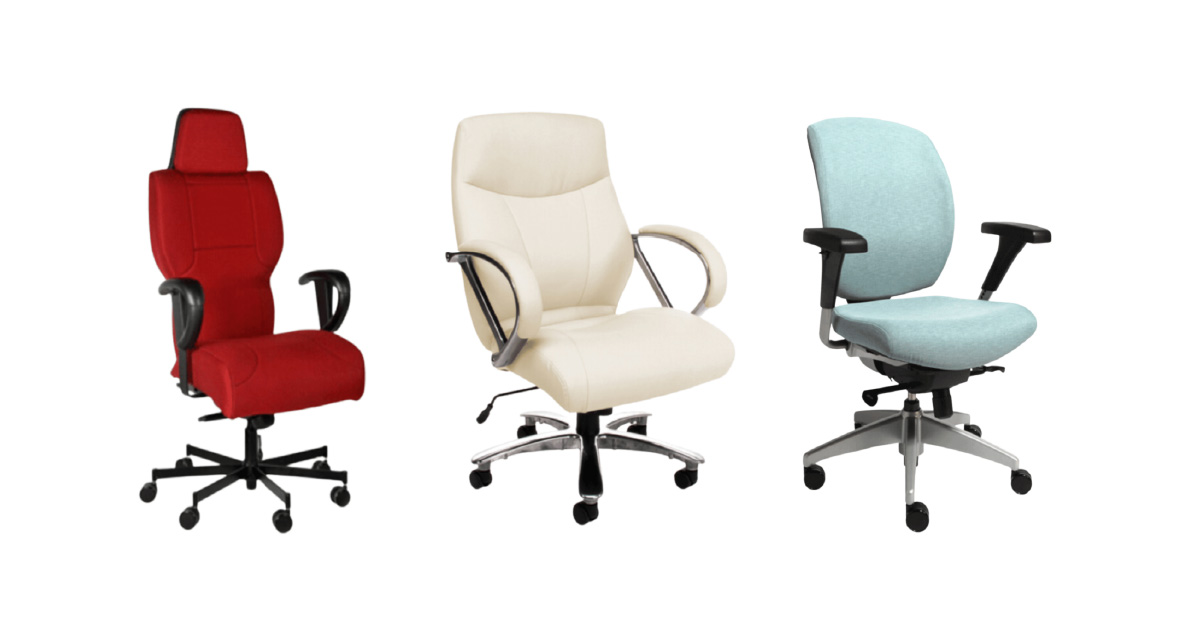O Where O Where my plus-size chair...and why is it uncomfortable and broken already? Few things are more disruptive to your work life and productivity than using the wrong tools for the job. A craftsman performs better with an electric saw, as does a chef with a good sharp knife. But when it comes to spending 8‐10‐12 hours per day in an office chair, we find ourselves working in some of the most counter-intuitive ways imaginable. And while this ergonomic issue is important for everyone working in office chairs, it is particularly critical to people of size, who are often working in chairs inappropriate for their bodies, uncomfortable, and potentially dangerous.
The first thing to know when shopping for a plus-size chair is it’s not, ‘just a chair.’ Speaking as a healthcare professional, I have seen first-hand the transformation that comes when the right piece of equipment is added into a person’s daily care, and not just because there’s no more discomfort and the body is now positioned naturally and healthfully--but due to the reduction in body stress. Because stress is a stealthy assassin, it comes in the details. The arm digging into your side, the seat's edges pinching your thighs, and most importantly--the rigidity from holding your body as if you might fall, all add to the stress.
The right user interface in the office (your chair, your desk, the position of your monitor) should turn invisible when they are all in alignment. They should be doing everything they are supposed to do and nothing they are not. But how do you find an invisible chair?
The product choices available today are plentiful. Many companies have added plus‐sized products to their offerings, but only some of them address a need whereas others have merely identified an opportunity for profit. There are special considerations when it comes to the plus‐sized client and it takes more than merely making a ‘big chair’ to address a customer’s specific needs. No two bodies are ever the same. This holds regardless of the community to which, you belong. And so, in your search, look for a company that specializes in serving plus-size or disabled customers. Find someone who wants to talk to you about your chair, not the one they can sell you, but the one you need.
Most Important
In a chair, there’s a basic set of VIP Figures we have to consider. Before we worry about the articulating headrest or the foldaway arms, or even the high‐end leather, we have to consider and address what takes the stresses off of our bodies. Let’s talk about those dimensions for a moment.
- Seat Width: this one is a no‐brainer. This dimension ensures accommodating comfort across the chair and ensures the fit between the arms is comfortable and trouble‐free. Not too wide though. Some bodies simply require a wide width, but at some point ‐ usually when you’ve exceeded your shoulder’s width plus 5‐6” ‐ the arms become unusable because they are just too far away.
- Seat Height: Knees slightly below hips, not too much, but get it right and it assists in standing. Seat heights in the industry are measured from the top of the seat to the floor.
- Seat Depth: One of the MOST important (and hardest to find) is a proper seat depth. This is the dimension that keeps you from feeling like you are slipping out of the front of the chair, the dimension that keeps you centered on the chair and prolongs the chair’s life.
Armed with these three vital chair‐to‐body specifications, we have what we need to get into building the ‘invisible chair’. If you can’t get an exact match to your body’s needs in these, get as close as possible, and if you can’t get close, move on. Now let’s get a bit more advanced.
Going Deeper
- Weight Capacity: The common thinking is that if you weigh 500 lbs, buy a 500 lbs capacity chair. This is not so. Task chairs have a great many moving parts, and rely on the strength of a single cylinder to achieve their weight capacity. Even if the chair components do perform without trouble, that gas cylinder is going to weaken very quickly and we’ll be looking at repair/replacement much faster than we wanted.
- Aim for a minimum of 50 lbs over your weight capacity needs (100 is better, but can be difficult to find or afford), i.e. if you weigh 305, aim for a 360 or higher for product longevity and a trouble-free chair experience.
- Arms: We’re not talking about arm features here, like rotation, pivot, folding... those might be important to your work experience need, but first other factors. Do you use the arms of a chair to help you control it while sitting/standing? Do you need to bear a lot of weight on them to sit/stand smoothly? If so, you may wish to look for a chair with fixed arms. Fixed arms are stronger and more rigid than their adjustable counterparts.
- If you don’t need a fixed arm, consider an adjustable arm that is both vertically and horizontally adjustable, so that you can move them out and away from your body.
- The Mechanism: Very important to your experience, the Mechanism is that big, metal box bolted to the underside of the seat, that lets it do all its positioning things. Mechanisms generally give you a lot of options or only a few, and the choice is entirely your preference. As someone who likes to customize to a client’s needs, I lean toward the mechanisms that offer a lot of options, but others prefer a simpler mech that is less likely to get ‘accidentally adjusted’ and costs you a half hour to get it feeling right once more. Ultimately the type of mechanism you choose is a personal preference. The multi‐function mechanisms might be needed to put you in exactly the right position, but if they are a source of anxiety for you, keep it simple.
- The Casters: Almost every chair comes with two primary caster options and a glides option. Glides are simply those little bell‐shaped pieces you find at the bottom of chairs in place of wheels. They don’t roll. They are intended to ‘glide’ as you drag the chair, then grip when you sit.
- The caster options are usually soft floors or hard floors. The terms are oversimplified. 75% of us can use a soft floor/universal caster for moving around on things like mats, carpets, and even most linoleum. But if you are using a chair on tile, concrete, hardwood, or other truly stiff surfaces, the hard floor caster is the better choice because they are designed to avoid leaving marks on that floor and roll better on harder surfaces.
- There are a lot of after‐market specialty casters that offer various functions, (bigger caster size means higher seat height, but easier rolling, rubberized protects hardwood best, etc.,) but beware. Installing these can void warranties.
- Casters are measured by individual capacity, so a 500 lbs chair likely utilizes a 110 lbs capacity caster (110 x 5). Replacing casters with after‐market options also requires knowledge of the caster stem size, which, can vary from chair to chair.
- The Bases: Most bases come in five‐point star shapes. They can be made from different materials, from plastic (avoid), nylon/fiberglass, chrome, and steel. Recently, the industry has made a move toward six and even seven‐point bases as they move easier and distribute weight more evenly, taking pressure off the performance of an individual wheel. I love the seven‐point bases and wish that all chairs would adopt this model, but most are still using fives. That said, there’s nothing wrong with a five‐point base, but once you have a seven‐point, there’s no comparison.
- The Footstool: Any ergonomist’s favorite add‐on is the footstool. Proper utilization of a footstool in combination with any chair, keeps your body properly aligned and centered in your seat while seated, and then lowers your knees below your hips for easier chair exit when it’s time to stand up. The often overlooked, humble footstool can also greatly extend the life of the chair.
There are some other workday-enhancing items you can choose from, like lumbar, articulating headrests, coccyx cutouts, foam upgrades, and neck rolls/headrests. These are fun personal choices, and the need for these items varies by person.
Category & Price
Finally, there is one last piece to consider before you buy; the categories of the industry. Most people don’t know that there are different categories of chairs, no matter plus‐sized or not. And as you would guess, each category also falls into a general budget. The categories are:
Home Office/Light Use Chairs
These are the chairs you find in box stores. They usually cost between $300‐$600, offer very few customizations, and use extremely simple mechanisms, (and often, low-quality upholsteries.) These are intended for very light use for maximum product life, 4‐8 hours per day. These chairs usually have a 1‐year warranty and are typically imported in bulk. These are the chairs you roll out to the curb and buy another when they break.
Professional Office Chairs
Professional office plus-size chairs usually cost around $1-$1.5K, come with many options, and are usually made in the USA or Canada. Domestic manufacturing offers critical advantages including, shorter lead times, and the opportunity to customize. These chairs typically utilize professional upholsteries and are intended for a single-shift daily usage of 8‐12 hours. Professional office chairs usually come with a warranty of greater than five years and have good product support. More, these are ‘component chairs’, meaning if something breaks whether in or out of warranty, you can buy parts to keep them going and every part is available.
Continuous Use/Intensive Use
These chairs can be quite expensive, in a range of $1.5-$4K, but they are ‘chairs for life’. They have all the options and are designed for round‐the‐clock use, 24/7/365 days a year. They utilize high-end professional upholsteries and usually come with ten-year warranties or greater.
Specialty/Industrial
These chairs are usually specific to an industry, for example – Cleanroom Chairs are built in such a way that they can be utilized in a sterile environment; Teller/Drafting Stools are specific to elevated workstations, etc.
State of the Industry
The plus-size chair industry has grown and matured over the past 25 years, and there are many quality choices for consumers. 'Fully functional' chairs, meaning they offer all of the options that quality standard-weight chairs offer, are readily available up to 500 lb capacity. But options dwindle as weight capacity increases. In part, this is due to some inherent design challenges to properly designing for larger bodies, like making use of tilt mechanisms. While they are abundantly featured in chairs with capacities of 550 lbs or lower, they are very difficult to make sturdy enough in chairs with higher weight capacities. Also, the very nature of a gas cylinder is that it will lose strength over time. It’s unavoidable, and finding gas cylinders with capacities above 550 lbs is difficult. There are product options that address high-capacity, tilt, and 550+ lb cylinders, but they are rarer.
Getting Your Chair
Purchasing a plus‐sized chair is easy with just a few mouse clicks, but getting the RIGHT chair, the ‘invisible chair’ requires experience, knowledge, and care. Don’t just buy one online because it 'seems' right. Open a dialogue with the company and talk about your needs frankly and openly. If you take care and find a knowledgeable representative, you’ll get much closer to ensuring that your body and your mind are rid of the stressors of discomfort.
Looking to start your search for the perfect plus-size chair.



